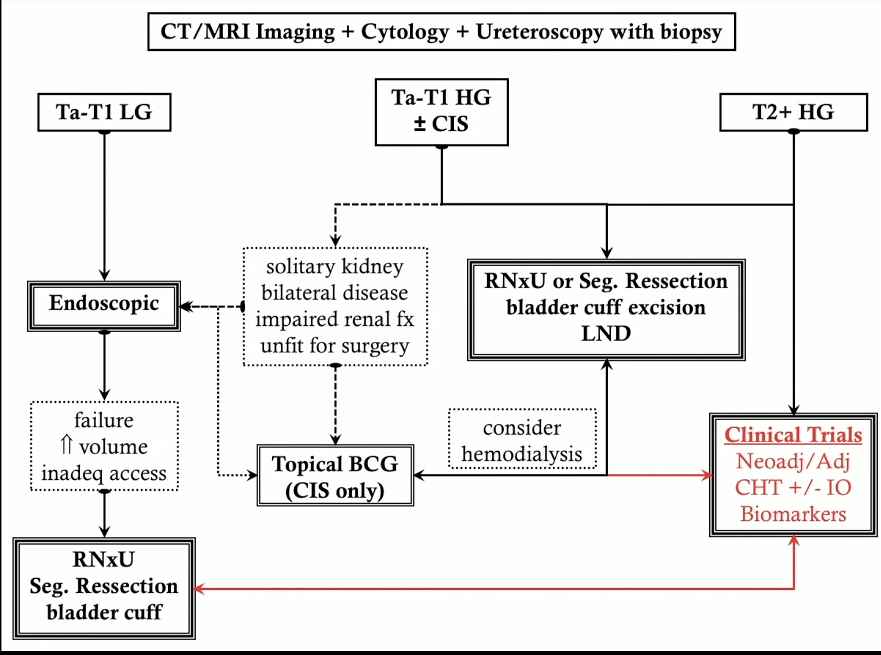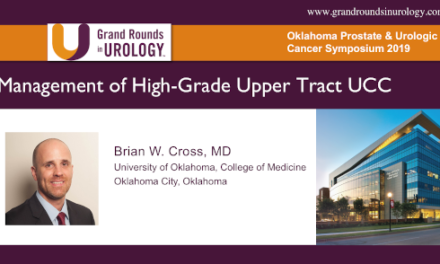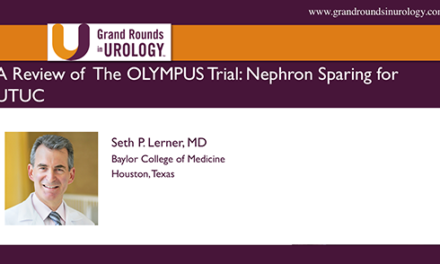Guilherme Godoy, MD, MPH, presented “Management of Upper Tract Urothelial Cancer” during the 23rd Annual Innovations in Urologic Practice on September 14, 2018 in Santa Fe, New Mexico.
How to cite: Godoy, Guilherme. “Management of Upper Tract Urothelial Cancer” September 14, 2018. Accessed [date today]. https://dev.grandroundsinurology.com/management-of-upper-tract-urothelial-cancer/
Management of Upper Tract Urothelial Cancer – Summary:
Guilherme Godoy, MD, MPH, provides a brief overview of the pathogenesis and epidemiology of upper tract urothelial carcinoma (UTUC). He then reviews genomic classification, diagnosing and staging, current oncological principles of surgical therapy, and new risk-adapted treatment options for the disease.
Abstract:
UTUC is a multifocal disease with a propensity to recur, and accounts for 90% of all urothelial cancers. Of those cancers, UTUC accounts for 5% of those cases and renal tumors account for 5%-7%. Balkan endemic nephropathy (BEN), as well as behavioral, occupational, and hereditary factors ascribe to the epidemiology and etiology of UTUC.
New data describing unique molecular and clinical subtypes of the disease supports using the genomic classification to drive therapy. Additionally, recent data from Memorial Sloan Kettering correlates genomic alterations of tumors biopsy samples to nephroureterectomy specimens.
Hematuria, flank pain, dysuria, and consumptive symptoms are indications to consider when diagnosing and staging UTUC. Patients should first undergo radiologic diagnostic evaluation to rule out possible differential diagnoses. However, endoscopic or ureteroscopic tests, histologic information from biopsy, cytology, or a combination of methods, may provide more diagnostic accuracy. The updated National Comprehensive Cancer Network (NCCN) TNM Staging System provides further guidance, specifically in nodal staging.
Radical nephroureterectomy (NU) with bladder cuff excision is currently the standard of care surgery for UTUC. Overall, evidence supports a laparoscopic NU approach over an open approach. Acceptable methods for the management of distal ureter and bladder cuff excision include intravesical or extravesical cystostomy, as well as transurethral resection and disarticulation.
While there are appropriate conservative options for non-muscle invasive, low-grade UC, there are few options for non-muscle invasive, high-grade tumors. Mapping lymph node metastases can help to guide lymph node dissection. New technologies, such as narrow-band imaging and endoluminal ultrasound, can aide in the identification of tumors. There are limited conservative options for invasive, high-grade tumors, but emerging evidence regarding MitoGel™, perioperative chemotherapy, and neoadjuvant chemotherapy are encouraging.
About Innovations in Urologic Practice
Innovations in Urologic Practice (IUP) is an annual CME-accredited conference devoted to updating urologists on the rapidly changing healthcare environment. Topics focus on innovative diagnostic and treatment strategies, controversies, new and currently developing technologies, and challenges in today’s urologic practice. Dr. Godoy presented this lecture during the 23rd IUP in 2018. Please visit this page in order to learn more about future IUP meetings.
ABOUT THE AUTHOR
Dr. Godoy is an Assistant Professor of Urology and Urology Oncology at Baylor College of Medicine, Houston, Texas. He received his MD from Fundacao Universitaria do ABC in Sao Paulo, Brazil, and has received numerous fellowships at several institutions, including Memorial Sloan Kettering Cancer Center in New York City, Irmandade da Santa Casa de Misericordia de Sao Paulo Medical School in Sao Paulo, Brazil, Vancouver General Hospital in Vancouver, British Columbia, New York University School of Medicine in New York City, and Baylor College of Medicine. Dr. Godoy is skilled at managing patients with bladder cancer, kidney cancer, prostate cancer, and testis cancer. He also specializes in bladder issues, erectile dysfunction, kidney stones, and prostatitis. Dr. Godoy is a respected writer, researcher, and presenter as well, and has published numerous articles and papers. He has won a Best Published Clinical Research Paper Award from European Urology and has been recognized on several occasions as a Best Poster of the Section at American Urological Association Annual Meetings and European Association of Urology Annual Congresses. Dr. Godoy is also heavily involved in the medical community, both nationally and internationally. He is a member or candidate member of nine medical societies, including the Pan American Society of Anatomy, the Brazilian Society of Anatomy, the American Association of Cancer Research, and the Southwest Oncology Group.






